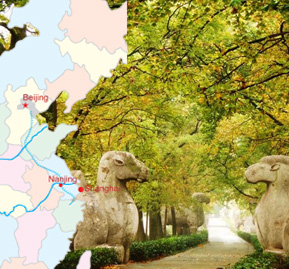|
|
|

As the capital of Jiangsu province, Nanjing lies on the south bank of the Yangtze River and boundary area of Jiangsu and Anhui. It houses around 6.17million people and covers an area of 6,598 sq.km. It is the second largest city in eastern China.
Nanjing is hot spot both rich in brilliant cultural heritages and tourism resources. As early as the Spring and Autumn Period (770B.C.-476B.C.), the Wu State had set up Ye county to govern the land for its important position. In 306.B.C., Chu State occupied the land, built the city on the famous Stone Mountain and set up the Jinling county. (Now the relic still stand in the same place). However, during the period from 195 A.D. to 557 A.D., it was rapidly prospered and developed into the largest metropolis in the world when the city was served as capital of Six dynasties. In Ming dynasty, the first emperor built the largest city wall in the world and his spectacular tom-Mingxiao Mausoleums which are still well-preserved. Beautiful mountains, fascinating lakes, flourished forest make the city a charming destination for tourists. Besides, Tangshan is one of the finest hot spring sites in China, which attracts a lot of arrivals every year.
What¡¯s more, Nanjing is also an important industry base where the electronic, automobile and chemical industries are in the leading position in eastern China. For its natural harbor and superior location, Nanjing has become a center of the transportation network and communication system of eastern China. All the above make Nanjing a second position among the cities in eastern China. |
|
